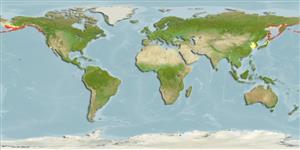Common names from other countries
>
Perciformes/Zoarcoidei (Eelpouts and pricklebacks) >
Stichaeidae (Pricklebacks) > Alectriinae
Etymology: Alectrias: Greek, alektros, -os, -on = single, married in illegal or unhappy marriage (Ref. 45335).
More on author: Pallas.
Environment: milieu / climate zone / depth range / distribution range
Écologie
marin démersal; profondeur 0 - 100 m (Ref. 50550), usually ? - 50 m (Ref. 51666). Temperate
Northwest Pacific: Commander Islands and southeastern Kamchatka to the Sea of Okhotsk and northern Sea of Japan. Northeast Pacific: Alaska.
Taille / Poids / Âge
Maturity: Lm ? range ? - ? cm
Max length : 10.0 cm SL mâle / non sexé; (Ref. 43239)
Description synthétique
Clés d'identification | Morphologie | Morphométrie
Épines dorsales (Total) : 59 - 66; Rayons mous dorsaux (Total) : 0; Épines anales: 1; Rayons mous anaux: 41 - 45; Vertèbres: 64 - 70. Gray to nearly black to bright spotted with patterns; usually a wavy line extending along back, separating dark portion from lighter spots that continue onto dorsal fin (Ref. 43939). Caudal fin rounded.
Mainly intertidal, but may be found at depths as much as 100 m (Ref. 43939); typically found shallower than 50 meters (Ref. 51666). Often in bays with pebble-rock debris bottoms (Ref. 43939). Oviparous, eggs are guarded by the female parent (Ref. 58332).
Life cycle and mating behavior
Maturities | Reproduction | Spawnings | Egg(s) | Fecundities | Larves
Mecklenburg, C.W., T.A. Mecklenburg and L.K. Thorsteinson, 2002. Fishes of Alaska. American Fisheries Society, Bethesda, Maryland. xxxvii +1037 p. (Ref. 43939)
Statut dans la liste rouge de l'IUCN (Ref. 130435)
CITES (Ref. 128078)
Not Evaluated
Menace pour l'homme
Harmless
Utilisations par l'homme
Outils
Articles particuliers
Télécharger en XML
Sources Internet
Estimates based on models
Preferred temperature (Ref.
115969): 2.3 - 12.9, mean 6 (based on 248 cells).
Phylogenetic diversity index (Ref.
82804): PD
50 = 0.5156 [Uniqueness, from 0.5 = low to 2.0 = high].
Bayesian length-weight: a=0.01000 (0.00244 - 0.04107), b=3.04 (2.81 - 3.27), in cm Total Length, based on all LWR estimates for this body shape (Ref.
93245).
Niveau trophique (Ref.
69278): 3.1 ±0.44 se; based on food items.
Résilience (Ref.
120179): Milieu, temps minimum de doublement de population : 1,4 à 4,4 années (Preliminary K or Fecundity.).
Fishing Vulnerability (Ref.
59153): Low vulnerability (10 of 100).
